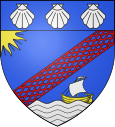Saint-Pierre-d'Oléron
| Saint-Pierre-d'Oléron | ||
|---|---|---|

|
|
|
| region | Nouvelle-Aquitaine | |
| Department | Charente-Maritime | |
| Arrondissement | Rochefort | |
| Canton | Île d'Oléron | |
| Community association | Île d'Oléron | |
| Coordinates | 45 ° 57 ′ N , 1 ° 18 ′ W | |
| height | 0-15 m | |
| surface | 40.55 km 2 | |
| Residents | 6,743 (January 1, 2017) | |
| Population density | 166 inhabitants / km 2 | |
| Post Code | 17310 | |
| INSEE code | 17385 | |
 Saint-Pierre-d'Oléron - View over the roofs of the village from the church tower of Saint-Pierre |
||
Saint-Pierre-d'Oléron is a western French municipality with 6743 inhabitants (at January 1, 2017) on the second largest French island of Ile d'Oleron in the department of Charente-Maritime in the region Nouvelle-Aquitaine .
location
Saint-Pierre-d'Oléron is located in the center or in the east of the island. The closest larger cities are Marennes (approx. 22 kilometers southeast) and Rochefort (approx. 45 kilometers east).
Population development
Already at the first census in 1793 the place had almost 4000 inhabitants.
| year | 1968 | 1975 | 1982 | 1990 | 1999 | 2007 | 2017 |
| Residents | 4258 | 4604 | 4782 | 5365 | 5944 | 6204 | 6743 |
economy
In the past the residents lived according to the principles of extensive self-sufficiency from fishing, agriculture and viticulture. The fishing for fish and crabs is still important; In addition, the place is now mainly known for the numerous oyster beds that are off the island. The Oléron oysters have their very own taste for which they are valued worldwide. The livestock industry no longer plays a significant role today, but vegetable growing has experienced a certain boom in the past few decades. Since the completion of the car bridge in 1966, tourism has played an increasingly important role in the city's economic life and has contributed to a significant increase in the population.
history

Little information is known about the history of the community; most of it coincides with the island's history. However, the place already existed in medieval times, which is well documented on the basis of the buildings (church and funeral lamp). In 1790 the first mayor ( maire ) was appointed.
Attractions
Death lantern
Others
- The three-aisled church of Saint-Pierre originally dates from the 12th century, but has undergone several far-reaching changes in the period that followed: Its current shape largely dates back to the 18th century. During the French Revolution , the church building was renamed La Fraternité . The interior of the church impresses with its simple design; the building has been classified as a monument historique since 1988 . On the walls there are several beautiful pictures from the 17th and 18th centuries, which are entered in the inventory list of the Monuments historiques .
- A castle in the Bonnemie district is mentioned for the first time in the 11th century. Today's castle was completely rebuilt in the 15th century and repeatedly revised in the following centuries. It was added to the lists of the Monuments historiques and the Base Mérimée in 1981. The château is privately owned and cannot be visited.
- The Maison des aïeux , built in 1739, was the home of the naval officer and novelist Pierre Loti from 1899 to 1923 , who also found his tomb in the garden. The house has been classified as a monument historique since 2011 .
- The Église Notre-Dame et Saint-Nicolas , built in the 1960s, is near the fishing port of La Cotinière; The triangular building was added to the list of Monuments historiques in 1991 as an outstanding example of modern church architecture .
See also: List of Monuments historiques in Saint-Pierre-d'Oléron
Partnerships
- Cariñena (Spain, since 1984)
- Spangenberg (Germany, since 1997)
- Pleszew (Poland, since 1997)
- Lane End (United Kingdom, since 1999)
The local school has been running a lively student exchange with the Burgsitzschule Spangenberg for over 25 years .
Personalities
- Henri Bréau (1900–1969), cyclist
literature
- Le Patrimoine des Communes de la Charente-Maritime. Flohic Editions, Volume 2, Paris 2002, ISBN 2-84234-129-5 , pp. 928-931.
Individual evidence
- ↑ Église Saint-Pierre, Saint-Pierre-d'Oléron in the Base Mérimée of the French Ministry of Culture (French)
- ↑ Église Saint-Pierre, Saint-Pierre-d'Oléron in the Base Mérimée of the French Ministry of Culture (French)
- ↑ Château de Bonnemie, Saint-Pierre-d'Oléron in the Base Mérimée of the French Ministry of Culture (French)
- ↑ Château de Bonnemie, Saint-Pierre-d'Oléron in the Base Mérimée of the French Ministry of Culture (French)
- ↑ Maison des aïeux, Saint-Pierre-d'Oléron in the Base Mérimée of the French Ministry of Culture (French)
- ↑ Chapelle Notre-Dame, Saint-Pierre-d'Oléron in the Base Mérimée of the French Ministry of Culture (French)
- ↑ a b Agreement on the partnership between the three cities ( memento of the original from January 11, 2012 in the Internet Archive ) Info: The archive link was inserted automatically and has not yet been checked. Please check the original and archive link according to the instructions and then remove this notice.
Web links
- Saint Pierre d'Oléron website (French)

